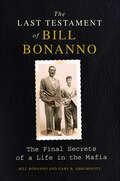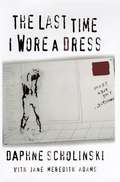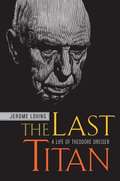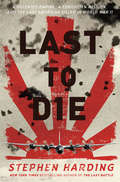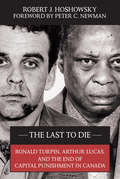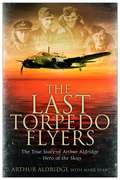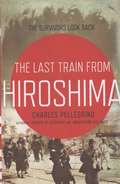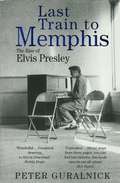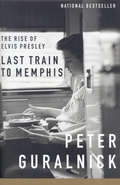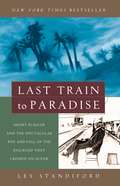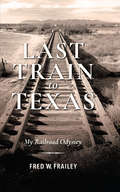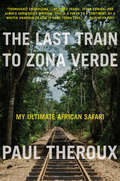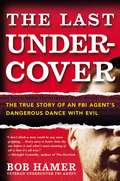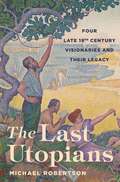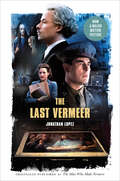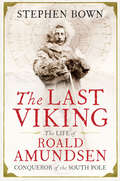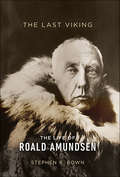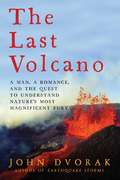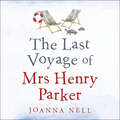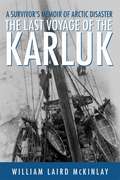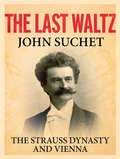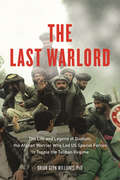- Table View
- List View
The Last Testament of Bill Bonanno: The Final Secrets of a Life in the Mafia
by Bill Bonanno Gary B. AbromovitzAn eye-opening look at life—and death—inside the Mafia, The Last Testament of Bill Bonanno is a stunning document written by the son of notorious crime boss Joe Bonanno. Published at the author’s request after his death, The Last Testament of Bill Bonanno provides highly confidential secrets about the inner workings of La Cosa Nostra—offering a behind-closed-doors look at the secret Commission meetings of the ’30s through ’60s and clandestine details of the Mafia’s most venerable rituals, techniques, and indoctrination ceremonies…plus pages of never-before-seen photos. Bonanno’s Last Testament stands alongside Talese’s Honor Thy Father, Pileggi’s Wiseguys, Maas’s The Valachi Papers and Underboss, The Good Rat by Jimmy Breslin, and T.J. English’s Havana Nocturne as an essential work of contemporary crime history—a must-read for fans of The Sopranos and The Godfather.
The Last Time I Wore a Dress
by Daphne ScholinskiAt the age of fifteen, Daphne Scholinski was put in a mental hospital for what her psychiatrist called? failure to identity as a sexual female.' The hospital gave her a diagnosis that was brand-new to the medical books: Gender Identity Disorder. The years that should have been Daphne's typical high school experience instead consisted of periods of seclusion and physical restraint, frequent does of sedatives, and the close company of people who were truly crazy. It’s hard to believe that doctors, circa 1981, described Daphne's treatment goals as becoming more obsessive about boys, learning about makeup, dressing more like a girl, curling and styling hair, and spending quality time learning about girl things with peers. Even now, after a decade and a half of our culture's coming to grips with homosexuality, approximately fifty thousand teenagers are institutionalized in the U.S. each year for being too sissy or too much of a tomboy. Though the facts are truly frightening, Jane Meredith Adams has captured Daphne's fresh, funny, triumphant voice so vividly that The Last Time I Wore a Dress is impossible to put down. The result is a book is reminiscent of The Catcher in the Rye and One Flew Over the Cuckoo's Nest as well as an expose of a shameful medical sham that has destroyed countless childhoods.
The Last Titan: A Life of Theodore Dreiser
by Jerome LovingA standard biography of one of America's best novelists, Theodore Dreiser, this book paints a full portrait of a writer who boldly swept away Victorian timidity to open the twentieth century in American literature.
Last to Die: A Defeated Empire, a Forgotten Mission, and the Last American Killed in World War II
by Stephen HardingOn August 18, 1945, US Army sergeant Anthony J. Marchione bled to death in the clear, bright sky above Tokyo. Marchione, a gunner in the US Air Forces, died like so many before him in World War II--quietly, cradled in the arms of a buddy. Though tragic, Marchione’s death would have been no more notable than any other had he not had the dubious distinction of being the last American killed in World War II combat. Based on official American and Japanese histories, personal memoirs, and the author’s exclusive interviews with many of the story’s key participants, Last to Die is a rousing tale of air combat, bravery, cowardice, hubris, and determination, all set during the turbulent and confusing final days of World War II.
The Last to Die: Ronald Turpin, Arthur Lucas, and the End of Capital Punishment in Canada
by Robert J. Hoshowsky Peter C. NewmanShort-listed for the 2008 Arthur Ellis Award for Best Crime Non-Fiction Although they committed separate crimes, Arthur Lucas and Ronald Turpin met their deaths on the same scaffold at Toronto’s Don Jail on December 11, 1962. They were the last two people executed in Canada, but surprisingly little was known about them until now. This is the first book to uncover the lives and deaths of Turpin, a Canadian criminal, and Lucas, a Detroit gangster. The result of more than five years of research, The Last to Die is based on original interviews, hidden documents, trial transcripts, and newspaper accounts. Featuring crime scene photos and never-before-published documents, this riveting book also reveals the heroic efforts of lawyer Ross MacKay, who defended both men, and Chaplain Cyril Everitt, who remained with them to the end. What actually happened the night of the hangings is shrouded by myth and rumour. This book finally confirms the truth and reveals the gruesome mistake that cost Arthur Lucas not only his life but also his head.
The Last Torpedo Flyers
by Arthur Aldridge Mark RyanImagine you are an RAF torpedo pilot in World War Two, sent on missions so dangerous that you're later likened to the Kamikaze. Suicide wasn't a recognised part of the objective for British airmen, yet some pilots felt they had accepted certain death just by climbing into their cockpits. There were times in 1942 when Arthur Aldridge felt like this. At the age of 19, this courageous young man had quit his studies at Oxford to volunteer for the RAF. He flew his Bristol Beaufort like there was no tomorrow - a realistic assumption, after seeing his best friend die in flames at the end of 1941. Aldridge was awarded a DFC (Distinguished Flying Cross) for his bravery on the same strike on a German cargo ship during which he lost a wing tip by flying too close to the deck. He was equally lucky to survive his squadron's chaotic torpedo attack on the giants of Hitler's maritime fleet during the notorious Channel Dash, which saw 40 RAF planes shot down. As 1942 wore on, and the stress became intolerable, Aldridge and his Cockney gunner Bill Carroll held their nerve, and 'Arty' was awarded a Bar to his DFC for sinking two enemy ships off Malta and rescuing a fellow pilot while wounded, as his own Beaufort took four shells. Malta was saved by the skin of its teeth, Rommel denied vital supplies in North Africa, and the course of the war was turned. Aldridge was still only 21 years old. Now both 91, but firm friends as ever, Aldridge and Carroll are two of the last torpedo airmen who deserve their place in history alongside our heroic Spitfire pilots. Their story vividly captures the comradeship that existed between men pushed by war to their very limit.
The Last Train from Hiroshima: The Survivors Look Back
by Charles PellegrinoDrawing on the voices of atomic bomb survivors and the new science of forensic archaeology, Charles Pellegrino describes the events and aftermath of two days in August when nuclear devices detonated over Japan changed life on earth forever. At the narrative's core are the eyewitness accounts of the people who experienced the effects of the atomic explosions firsthand. Thirty people are known to have fled Hiroshima for the imagined safety of Nagasaki--where they arrived just in time to survive yet another atomic bomb. Tsutomu Yamaguchi, who is still alive, is the only person known to have survived the full effects of the blast at Ground Zero both times. The second time, the blast effects were diverted around the stairwell of a building in which he had been standing, placing him and the small group of people standing with him in a shock cocoon, while the entire office building disappeared around them. Almost everything we know about the bombing turns out to be wrong. For all its fury the Hiroshima bomb had been compromised during a preflight test. Only hours before Enola Gay took off, on August 6, physicist Luis Alvarez juiced up the weakened bomb with three plugs of polonium and beryllium (the nuclear equivalent of inserting nitrous oxide into a race car's engine). A stunning "you are there" time capsule, The Last Train from Hiroshima is enriched by the author's scientific authority and close relationship with the bombs' survivors, making his account the most gripping ever written.
Last Train To Memphis: The Rise of Elvis Presley
by Peter GuralnickThis is the first of two volumes that make up what is arguably the definitive Elvis biography. Rich in documentary and interview material, this volume charts Elvis' early years and his rise to fame, taking us up to his departure for Germany in 1958. Of all the biographies of Elvis - this is the one you will keep coming back to.
Last Train to Memphis: The Rise of Elvis Presley
by Peter GuralnickFrom the moment he first shook up the world in the mid 1950s, Elvis Presley has been one of the most vivid and enduring myths of American culture. Last Train to Memphis: The Rise of Elvis Presley is the first biography to go past that myth and present an Elvis beyond the legend. Based on hundreds of interviews and nearly a decade of research, it tracks the evolution not just of the man but of the music and of the culture he left utterly transformed, creating a completely fresh portrait of Elvis and his world. This volume tracks the first twenty-four years of Elvis' life, covering his childhood, the stunning first recordings at Sun Records ("That's All Right," "Mystery Train"), and the early RCA hits ("Heartbreak Hotel," "Hound Dog," "Don't Be Cruel").These were the years of his improbable self-invention and unprecedented triumphs, when it seemed that everything that Elvis tried succeeded wildly. There was scarcely a cloud in sight through this period until, in 1958, he was drafted into the army and his mother died shortly thereafter. The book closes on that somber and poignant note. Last Train to Memphis takes us deep inside Elvis' life, exploring his lifelong passion for music of every sort (from blues and gospel to Bing Crosby and Mario Lanza), his compelling affection for his family, and his intimate relationships with girlfriends, mentors, band members professional associates, and friends. It shows us the
Last Train to Memphis: The Rise of Elvis Presley
by Peter GuralnickFrom the moment that he first shook up the world in the mid 1950s, Elvis Presley has been one of the most vivid and enduring myths of American culture.Last Train to Memphis: The Rise of Elvis Presley is the first biography to go past that myth and present an Elvis beyond the legend. Based on hundreds of interviews and nearly a decade of research, it traces the evolution not just of the man but of the music and of the culture he left utterly transformed, creating a completely fresh portrait of Elvis and his world.This volume tracks the first twenty-four years of Elvis' life, covering his childhood, the stunning first recordings at Sun Records ("That's All Right," "Mystery Train"), and the early RCA hits ("Heartbreak Hotel," "Hound Dog," "Don't Be Cruel"). These were the years of his improbable self-invention and unprecedented triumphs, when it seemed that everything that Elvis tried succeeded wildly. There was scarcely a cloud in sight through this period until, in 1958, he was drafted into the army and his mother died shortly thereafter. The book closes on that somber and poignant note.Last Train to Memphis takes us deep inside Elvis' life, exploring his lifelong passion for music of every sort (from blues and gospel to Bing Crosby and Mario Lanza), his compelling affection for his family, and his intimate relationships with girlfriends, mentors, band members, professional associates, and friends. It shows us the loneliness, the trustfulness, the voracious appetite for experience, and above all the unshakable, almost mystical faith that Elvis had in himself and his music. Drawing frequently on Elvis' own words and on the recollections of those closest to him, the book offers an emotional, complex portrait of young Elvis Presley with a depth and dimension that for the first time allow his extraordinary accomplishments to ring true.Peter Guralnick has given us a previously unseen world, a rich panoply of people and events that illuminate an achievement, a place, and a time as never revealed before. Written with grace, humor, and affection, Last Train to Memphis has been hailed as the definitive biography of Elvis Presley. It is the first to set aside the myths and focus on Elvis' humanity in a way that has yet to be duplicated.
Last Train To Memphis: The Rise of Elvis Presley
by Peter GuralnickThis is the first of two volumes that make up what is arguably the definitive Elvis biography. Rich in documentary and interview material, this volume charts Elvis' early years and his rise to fame, taking us up to his departure for Germany in 1958. Of all the biographies of Elvis - this is the one you will keep coming back to.
Last Train to Paradise: Henry Flagler and the Spectacular Rise and Fall of the Railroad that Crossed an Ocean
by Les StandifordThe story of the crazy idea to build a railroad over open ocean in the Florida Keys, its completion, and its complete destruction 22 years later in a hurricane is well told by author and Florida resident Standiford. Though the central protagonist is the oil tycoon Henry Flagler, who was a pivotal figure in the development of Florida's coast, Standiford never loses sight of the experience of the railroad's less well-known engineers and workers. Annotation c. Book News, Inc. , Portland, OR (booknews. com)
Last Train to Texas: My Railroad Odyssey (Railroads Past And Present Ser.)
by Fred W. FraileyA veteran railroad columnist takes readers on a wild ride through the American train industry with remembrances that crisscross the country and the world.In Last Train to Texas, author Fred W. Frailey examines the workings behind the railroad industry and captures incredible true stories along the way. He vividly portrays the industries larger-than-life characters, such as William “Pisser Bill” F. Thompson, who weathered financial ruin, bad merger deals, and cutthroat competition, all while racking up enough notoriety to inspire a poem titled “Ode to a Jerk.”Whether he’s riding the Canadian Pacific Railway through a blizzard, witnessing a container train burglary in the Abo Canyon, or commemorating a poem to Limerick Junction in Dublin, Frailey’s journeys are rife with excitement, incident, and the spirit of the rails. Filled with humorous anecdotes and thoughtful insights into the railroading industry, Last Train to Texas is a grand adventure for the railroad connoisseur.
Last Train to Texas: My Railroad Odyssey (Railroads Past And Present Ser.)
by Fred W. FraileyA veteran railroad columnist takes readers on a wild ride through the American train industry with remembrances that crisscross the country and the world.In Last Train to Texas, author Fred W. Frailey examines the workings behind the railroad industry and captures incredible true stories along the way. He vividly portrays the industries larger-than-life characters, such as William “Pisser Bill” F. Thompson, who weathered financial ruin, bad merger deals, and cutthroat competition, all while racking up enough notoriety to inspire a poem titled “Ode to a Jerk.”Whether he’s riding the Canadian Pacific Railway through a blizzard, witnessing a container train burglary in the Abo Canyon, or commemorating a poem to Limerick Junction in Dublin, Frailey’s journeys are rife with excitement, incident, and the spirit of the rails. Filled with humorous anecdotes and thoughtful insights into the railroading industry, Last Train to Texas is a grand adventure for the railroad connoisseur.
The Last Train to Zona Verde: My Ultimate African Safari
by Paul TherouxThe acclaimed author of Dark Star Safari journeys across western Africa in this &“thoroughly engrossing [and] at times tragic&” travelogue (Washington Post).Paul Theroux&’s best-selling Dark Star Safari chronicled his epic overland voyage from Cairo to Cape Town, providing an insider&’s look at modern Africa. Now, with The Last Train to Zona Verde, he returns to discover how both he and Africa have changed in the ensuing years. Traveling alone, Theroux sets out from Cape Town, going north through South Africa, Namibia, then into Angola, encountering a world increasingly removed from tourists&’ itineraries and the hopes of postcolonial independence movements. After covering nearly 2,500 arduous miles, Theroux cuts short his journey, a decision he chronicles with unsparing honesty in a chapter titled &“What Am I Doing Here?&” Vivid, witty, and beautifully evocative, The Last Train to Zona Verde is a fitting final African adventure from the writer whose gimlet eye and effortless prose have brought the world to generations of readers. &“If this book is proof, age has not slowed Theroux or encouraged him to rest on his achievements . . . Gutsy, alert to Africa's struggles, its injustices and history.&” — San Francisco Chronicle
The Last Undercover: The True Story of an FBI Agent's Dangerous Dance with Evil
by Bob HamerA 26-year veteran of the FBI reflects on the challenges he has endured and overcome, as he stared the dark side of humanity in the face and never blinked.
The Last Utopians: Four Late Nineteenth-Century Visionaries and Their Legacy
by Michael RobertsonThe entertaining story of four utopian writers—Edward Bellamy, William Morris, Edward Carpenter, and Charlotte Perkins Gilman—and their continuing influence todayFor readers reared on the dystopian visions of Nineteen Eighty-Four and The Handmaid's Tale, the idea of a perfect society may sound more sinister than enticing. In this lively literary history of a time before "Orwellian" entered the cultural lexicon, Michael Robertson reintroduces us to a vital strain of utopianism that seized the imaginations of late nineteenth-century American and British writers.The Last Utopians delves into the biographies of four key figures--Edward Bellamy, William Morris, Edward Carpenter, and Charlotte Perkins Gilman—who lived during an extraordinary period of literary and social experimentation. The publication of Bellamy's Looking Backward in 1888 opened the floodgates of an unprecedented wave of utopian writing. Morris, the Arts and Crafts pioneer, was a committed socialist whose News from Nowhere envisions a workers' Arcadia. Carpenter boldly argued that homosexuals constitute a utopian vanguard. Gilman, a women's rights activist and the author of "The Yellow Wallpaper," wrote numerous utopian fictions, including Herland, a visionary tale of an all-female society.These writers, Robertson shows, shared a belief in radical equality, imagining an end to class and gender hierarchies and envisioning new forms of familial and romantic relationships. They held liberal religious beliefs about a universal spirit uniting humanity. They believed in social transformation through nonviolent means and were committed to living a simple life rooted in a restored natural world. And their legacy remains with us today, as Robertson describes in entertaining firsthand accounts of contemporary utopianism, ranging from Occupy Wall Street to a Radical Faerie retreat.
The Last Vermeer: Unvarnishing the Legend of Master Forger Han van Meegeren
by Jonathan Lopez“A grand yarn of twisty deceit, involving prestigious dupes and scads of money, with a sensational trial at the finish.” —The New YorkerIt’s a story that made Dutch painter Han van Meegeren world-famous when it broke at the end of World War II: A lifetime of disappointment drove him to forge Vermeers, one of which he sold to Hermann Goering in mockery of the Nazis. And it’s a story that’s been believed ever since. Too bad it isn't true.Jonathan Lopez has drawn on never-before-seen documents from dozens of archives for this long-overdue unvarnishing of Van Meegeren’s legend. Neither unappreciated artist nor antifascist hero, Van Meegeren emerges as an ingenious, dyed-in-the-wool crook. Lopez explores a network of illicit commerce that operated across Europe: Not only was Van Meegeren a key player in that high-stakes game in the 1920s and ’30s, landing fakes with famous collectors such as Andrew Mellon, but he and his associates later cashed in on the Nazi occupation.Nominated for an Edgar Award and made into a film starring Guy Pearce, The Last Vermeer is a revelatory biography of the world’s most famous forger—a talented Mr. Ripley armed with a paintbrush—and a deliciously detailed story of deceit in the art world.Includes photographs“His pioneering research on van Meegeren’s early life gives us further insight into what motivates deception, a subject that will never cease to fascinate as long as art is bought and sold.” —ARTNews“Brings hard light to van Meegeren’s machinations and (very bad) character.” —The New Yorker“Fascinating . . . Lopez’s writing is witty, crisp and vigorous, his research scrupulous and his pacing dynamic.” —Publishers Weekly (starred review)“A terrific read.” —Houston Chronicle“It’s hard to imagine improving on Lopez’s gem of a tale.” —Los Angeles TimesPreviously published as The Man Who Made Vermeers
The Last Viking: The Life of Roald Amundsen, Conqueror of the South Pole (A\merloyd Lawrence Book Ser.)
by Stephen BownThis “fascinating biography” of the Norwegian explorer who beat Robert Scott to the South Pole is “intelligent and often thrilling” (London Sunday Times).The most feted explorer of his generation, Roald Amundsen counted the discovery of the Northwest Passage, in 1905, as well as the North Pole amongst his greatest achievements. His revolutionary approach to technology transcends polar and nautical significance. However, until now, his story has rarely featured as more than a footnote to Scott’s tragic failure.Reviled for defeating Scott but worshipped by his men, Amundsen was pursued by women and creditors throughout his life before disappearing on a mission to rescue an Italian explorer attempting to claim the North Pole for Mussolini. The Last Viking is the life of a visionary and a showman, who brought the era of Shackleton to an end, put the newly independent Norway on the map, and was the twentieth century’s brightest trailblazing explorer.
The Last Viking: The Life of Roald Amundsen (A Merloyd Lawrence Book)
by Stephen R. BownThe Last Viking unravels the life of the man who stands head and shoulders above all those who raced to map the last corners of the world. In 1900, the four great geographical mysteries—the Northwest Passage, the Northeast Passage, the South Pole, and the North Pole—remained blank spots on the globe. Within twenty years Roald Amundsen would claim all four prizes. Renowned for his determination and technical skills, both feared and beloved by his men, Amundsen is a legend of the heroic age of exploration, which shortly thereafter would be tamed by technology, commerce, and publicity. Féted in his lifetime as an international celebrity, pursued by women and creditors, he died in the Arctic on a rescue mission for an inept rival explorer. Stephen R. Bown has unearthed archival material to give Amundsen’s life the grim immediacy of Apsley Cherry-Garrard’s The Worst Journey in the World, the exciting detail of The Endurance, and the suspense of a Jon Krakauer tale. The Last Viking is both a thrilling literary biography and a cracking good story.
The Last Volcano: A Man, a Romance, and the Quest to Understand Nature's Most Magnificent Fury
by John DvorakRanging from Yellowstone in Wyoming to Mount Pelee in the Caribbean, from Bogoslof and Pavlov in Alaska, to Sakurajima in Japan, and, finally, to the massive volcanoes of Kilauea and Mauna Loa in Hawaii—The Last Volcano reveals the incredible journey of a man on a mission to understand the awesome power of volcanic eruptions. Volcanoes have fascinated—and terrified—people for ages. They have destroyed cities and ended civilizations. John Dvorak, the acclaimed author of Earthquake Storms, looks into the early scientific study of volcanoes and the life of the man who pioneered the field, Thomas Jaggar. Educated at Harvard, Jaggar went to the Caribbean after Mount Pelee exploded in 1902, killing more than 26,000 people. Witnessing the destruction and learning about the horrible deaths these people had suffered, Jaggar vowed to dedicate himself to a study of volcanoes. What followed was fifty years of global travel to eruptions in Italy, Alaska, Central America, Japan and the Pacific. In 1912, he built a small science station at the edge of a lake of molten lava at Kilauea volcano in the Hawaiian Islands, with the goal of solving the mystery of why volcanoes erupt and how they could be predicted. Jaggar found something else at Kilauea: true love. She was Isabel Maydwell, a widowed school teacher who came to Kilauea to restart her life. For more than twenty ears, she and Jaggar ran the science station, living in a small house at the edge of a high cliff that overlooked the lava lake. Maydwell would quickly becoming one of the world’s most astute observers of volcanic activity. Mixed with tales of myths and rituals, as well as the author’s own experiences and insight into volcanic activity, The Last Volcano reveals the lure and romance of confronting nature in its most magnificent form—the edge of a volcanic eruption.
The Last Voyage of Mrs Henry Parker: An unforgettable love story from the author of Kindle bestseller THE SINGLE LADIES OF JACARANDA RETIREMENT VILLAGE
by Joanna NellA poignant ode to love and the memories that make a well-lived life, from the author of THE SINGLE LADIES OF JACARANDA RETIREMENT VILLAGE As the wife of retired ship's doctor Dr Henry Parker, Evelyn is living out her twilight years aboard the Golden Sunset. Every night she dresses for dinner - gown, tiara, runners - and regales her fellow passengers with stories of a glamorous life travelling the world in luxury, as well as showing off her superior knowledge of everything from ships' customs to biographical details of her heroine, Florence Nightingale. The crew treat her with deference. And forbearance. But when Henry goes missing, Evelyn sets off to search every part of the grand ocean liner to find him, casino, nightclub and off-limits areas included. Misadventures are had, new friends are made, scandalous behaviour noted - all news to Evelyn. If only she could remember the events of the night before as clearly as she can recall the first time she met Henry on a passage from England to Australia in 1953 and fell in love, abandoning her dreams to become a midwife to be a wife instead - and the long-ago painful events that left Evelyn all at sea. Why is it so hard to forget some things and so hard to remember others? And where is Henry?(p)2019 Hachette Australia
The Last Voyage of the Karluk
by William Laird MckinlayAn astonishing narrative of disaster and perseverance, The Last Voyage of the Karluk will thrill readers of adventure classics like Into Thin Air and The Climb. In 1913, explorer Vilhjalmur Stefansson hired William McKinlay to join the crew of the Karluk, the leading ship of his new Arctic expedition. Stefansson's mission was to chart the waters north of Alaska; yet the Karluk's crew was untrained, the ship was ill-suited to the icy conditions, and almost at once the Karluk was crushed-at which point Stefansson abandoned his crew to continue his journey on another ship. This is the only firsthand account of what followed: a nightmare struggle in which half the crew perished, one was mysteriously shot, and the rest were near death by the time of their rescue twelve months later.Written some sixty years after the fact, and drawing extensively on his own daily log, McKinlay's narrative of this doomed expedition is rendered with remarkable clarity of recollection, and with a combination of horror and a level of self-possession that, to modern eyes, may seem incredible. Like most of his companions, McKinlay was inexperienced, without a day's training in the skills essential to survival in the Arctic. Yet he and many of his fellow crewmen, with the help of an Eskimo family accustomed to such conditions, survived a year under the harshest of conditions, enduring 80-mile-per-hour gales and temperatures well below zero with only the barest of provisions and almost no hope of contact with civilization.Nearly a century later, this remains one of the most compelling survival stories ever written-an extraordinary testament to man's overpowering will to live.
The Last Waltz: The Strauss Dynasty and Vienna
by John SuchetCaptured in a beautiful package, including more than fifty color photographs, The Last Waltz tells the intriguing story of of the Viennese Strauss family known for producing some of the best known, best loved music of the nineteenth century. Johann and Josef Strauss, the Waltz Kings, composed hundreds of instantly recognizable and enduringmelodies, including The Blue Danube Waltz, Tales from the Vienna Woods, Voices of Spring and The Radetzky March. Their iconic music has been featured on the scores of nearly a thousand films.Yet despite their success, this was a family riven with tension, feuds and jealousy, living in a country that was undergoing seismic upheaval. Through the personal and political chaos, the Strauss family continued to compose music to which the Viennese - anxious to forget their troubles - could dance and drank champagne, even as their country hurtled towards oblivion at the hands of the First World War. Classical music expert and radio host John Suchet skillfully portrays this gripping story, capturing the family dramas, the tensions, triumphs and disasters against the turbulent backdrop of Austria in the nineteenth century, from revolution to regicide.
The Last Warlord: The Life and Legend of Dostum, the Afghan Warrior Who Led US Special Forces to Topple the Taliban Re
by Brian WilliamsChronicling the spectacular rise to power of General Abdul Rashid Dostum, this is an intimate profile of the one of the most powerful warlords to have dominated Afghanistan in the years since the Soviet withdrawal in the late 1980s. His rise from simple peasant villager to warrior against the repressive policies of the Taliban and Al Qaeda is told by one of the few outsiders to be accepted into Dostum's stronghold in the northern deserts of Afghanistan. Thanks to this unprecedented access, author Brian Glyn Williams was able to conduct lengthy interviews with Dostum and his family, as well as his subcommanders, local chieftains, mullahs, Taliban enemies, prisoners of war, and women's rights activists. What emerges is an intensely personal account of the Mongol warlord, detailing his childhood, motivations, hopes for his country, and conviction that it is time for a new generation of Western-trained technocrats to shape his country's destiny. With the drawing down of U.S. troops in 2014 and Dostum poised to reenter the world stage to fight a resurgent Taliban, this timely analysis provides important historical context to the controversy swirling around Afghanistan's warlord culture and is an essential contribution to the debate on Afghanistan's future.
